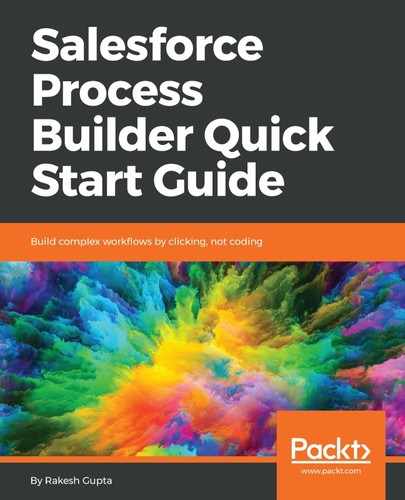Packages give you the flexibility to deploy Processes in any Salesforce organization, which means that if you have developed a Process in a free developer organization and want to share it with your colleagues, they can install it in their Salesforce developer organization. In this case, the two Salesforce organizations are not connected.
Let's look at a business scenario. Joe Thompson is working as a system administrator at Universal Containers. He has developed the Auto create new Contract process in Chapter 1, Getting Started with Lightning Process Builder, in his personal developer organization. Now he wants to install this process in his organization's Full Sandbox.
When the organizations are not connected, you can use a package to migrate the application, code, or any other changes. If a package (Managed - Released) contains Apex code, Flows, or Processes, then you can only install the packages in Developer Edition, Lightning Enterprise Edition, or higher, if the package doesn't pass the AppExchange security review. If a package that contains Apex code passes the security review, then you can install this type of application in any of the Salesforce editions, even in Lightning Professional Edition or below. To solve the preceding business requirement, we will create an unmanaged package. Perform the following steps to create a package:
- In Lightning Experience, navigate to Setup (Gear Icon) | Setup | PLATFORM TOOLS | Apps | Package Manager, click on the Packages section, and then click on the New button.
- It will redirect you to a new window, where you have to enter Package Name, Language, Configure Custom Link, Notify on Apex Error, and Description, as shown in the following screenshot:

- Once you are done, click on the Save button; it will redirect you to the Package Detail page.
- The next task is to add components to the package. To do that, click on the Components tab, and then click on the Add button, as shown in the following screenshot:

It will redirect you to the Add To Package page, where you can add different components to the package.
- From the Component Type dropdown, choose the Flow Definition option, and then select the Auto create new Contract process, as shown in the following screenshot:

- Once you are done, click on the Add To Package button. It will redirect you to the Package Detail page. Make sure that you have added all the dependent components that are used in Process Builder.
- Once you are done, the next step is to upload the package. To do that, click on the Upload button; it will redirect you to the Upload Package page, where you have to enter the version name as Summer2018, 2.0 for the version number, and the requirements to install a package. Once you are done, click on the Upload button.
- After a successful upload, you will get an email from Salesforce with a link to install the package in any organization, as shown in the following screenshot:

If you're planning to install this package in a developer organization, use the link as it is. To install this package in a Sandbox, replace login with test; it will then look like the following URL:
https://test.salesforce.com/packaging/installPackage.apexp?p0=04tB00000009KbD
We have created an unmanaged package to distribute the Processes. Using this URL, anyone will be able to install the package in their organization. You can make it secure by adding a password at the time of package creation.
